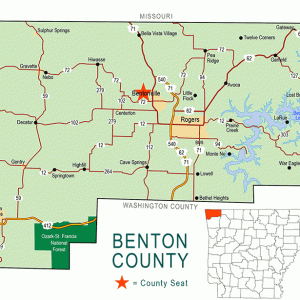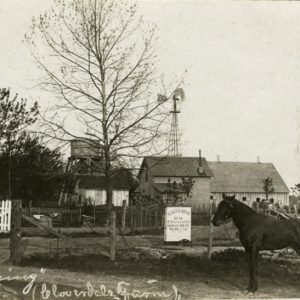calsfoundation@cals.org
Springtown (Benton County)
| Latitude and Longitude: | 36°15’39″N 094°25’24″W |
| Elevation: | 1,204 feet |
| Area: | 0.54 square miles (2020 Census) |
| Population: | 83 (2020 Census) |
| Incorporation Date: | June 7, 1909 |
Historical Population as per the U.S. Census:
|
1810 |
1820 |
1830 |
1840 |
1850 |
1860 |
1870 |
1880 |
1890 |
1900 |
|
– |
– |
– |
– |
– |
– |
– |
– |
– |
– |
|
1910 |
1920 |
1930 |
1940 |
1950 |
1960 |
1970 |
1980 |
1990 |
2000 |
|
– |
– |
97 |
104 |
102 |
82 |
– |
– |
– |
114 |
|
2010 |
2020 | ||||||||
|
87 |
83 |
Springtown is a small town in western Benton County, between Gentry (Benton County) and Highfill (Benton County), about eighteen miles southwest of Bentonville (Benton County). Named for a natural spring, the source of Flint Creek, the town has maintained a population of around 100 since its incorporation in 1909.
The Osage hunted and fished in northern Arkansas until a series of treaties moved them to Indian Territory (now the state of Oklahoma). Settlers arrived in northwestern Arkansas almost as soon as Arkansas had become a state. Charles Kincheloe built the first house in what is now Springtown in 1841. Shortly thereafter, Isaac Dial built a house near the spring for which the town is named.
Civil War activity around Bentonville disrupted the economy of the region, and the first store—built by Manning Richardson—did not open until 1868. A post office had been established in the area in 1856, but it was known as Hickory until 1874. The town was platted in 1871. One building in the new town had a school on the first floor and a Masonic lodge on the second floor. A Methodist church was established in 1881.
According to the Goodspeed history of Benton County, in 1889, Springtown had a grocery and hardware store, a drugstore, a hotel, a steam grist mill and sawmill, two blacksmiths, two shoemakers, three doctors, a Baptist church, a Methodist Episcopal church, and a Methodist Episcopal South church. During the 1880s, Springtown was regarded as a boom town, but its prospects failed when the Kansas City Southern Railroad was built three miles to the west. Many businesses and residents relocated, creating the community called Orchard, which is now the city of Gentry. However, a new larger steam mill was built in Springtown around 1900.
According to an article in the Benton County Sun in 1907, Springtown was on the Rogers Southwestern Railroad line. Natural gas had been found in the area, and the Spring Town Oil, Gas, and Mineral Development Company was being organized. A bank was also being established. At this time, the town had a public school, two churches, five stores, two parks, and a blacksmith. Fruit was the primary crop in the farmland surrounding Springtown.
The community was heavily damaged by a fire on October 16, 1908. The next year, it incorporated as a town. The bank closed by 1915, at which time the town still had four general stores and a drugstore. Historian J. Dickson Black wrote that, by 1936, “the town just kept getting smaller ’til there was just a store or two and the post office.” Gentry continued to grow, and the Springtown schools were consolidated into the Gentry School District. The Methodist church celebrated its centennial in 1981, but it had closed by 1995. The post office closed in 1998.
For additional information:
Benton County Heritage Committee. History of Benton County, Arkansas. Rogers, AR: Benton County Heritage Committee, 1991.
Black, J. Dickson. History of Benton County, 1836–1936. Little Rock: International Graphics Institute, 1975.
Goodspeed’s 1889 History of Benton County, Arkansas. Bentonville, AR: Benton County Historical Society, 1993.
Steven Teske
Butler Center for Arkansas Studies
 Benton County Map
Benton County Map  Cloverdale Farm
Cloverdale Farm 




Comments
No comments on this entry yet.